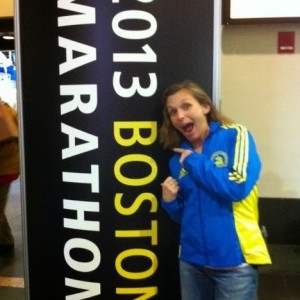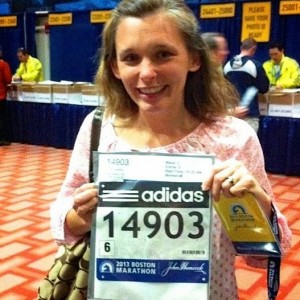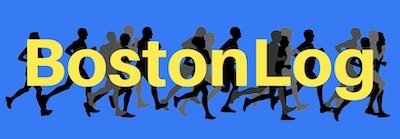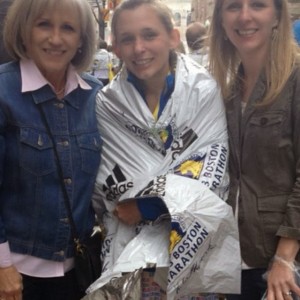When I was in high school, my family went skiing in Colorado. At the top of the snow covered mountains, the view was breathtaking! We took rolls and rolls of film (this was so long ago, cameras had film!) so we could share the experience with friends. When we got home and got our pictures developed, the pictures were pretty, but it was sort of a letdown… Our pictures did not come close to conveying the beauty and magnitude of the mountains. In many ways, the Boston Marathon is like those mountain top pictures: one of those experiences hard to adequately convey. But I will try!
First, I want to give you some facts I think help explain why Boston is such a big deal to runners. Most of the following bullet points are taken from Bill Rogers’s book, Marathon Man. We actually got to hear him speak about some of his Boston experiences the night before the marathon!
•The race has been held on Patriots’ Day every April since 1897. [The holiday commemorates the anniversary of the opening battles of the Revolutionary War, and, of course, the most famous run of all, Paul Revere’s midnight ride on April 18, 1775, to warn the patriots in Lexington and Concord the British were coming.]
•Fifteen runners participated in that first race in 1897; ten finished.
•Boston oozes prestige and tradition. It’s the oldest continuously run marathon in the world, held on almost the exact same course for over a century- a course patterned after the ancient route from Marathon to Athens.

•It is a point to point course which goes through several suburbs of Boston and then into the city itself, finishing in the downtown area. Early race day morning, thousands and thousands of runners line up at the Boston Common to board school buses. The “yellow dogs” carry everyone out to the high school in Hopkinton, where the race starts. [The ride takes about 45 minutes, and I remember a girl and I laughing when she said, “We have been on this bus a long time… You mean to tell me we have to go back the whole way… on foot?!”
•Once the race starts, there is very little flat ground (which was a bit of a surprise to my legs). Heartbreak Hill, the most significant and widely known hill in all of road racing, is the culmination of a Killer Chain of hills. Their reputation is earned not because of their severity, but because of their location, between mile 16 and mile 21, when legs start tightening and spirits begin to break.
•Boston is also famous as the only marathon in the world for which the average runner has to qualify. Runners must meet certain times based on their age and gender, in order to register for the race. For example, within the last year, a woman between the ages of 35 and 39 has to have run a marathon faster than 3:40, which is an 8:23 per mile average pace.
•Runners from all over the world, from remote parts of the Ukraine to mud-hutted villages of Kenya, grow up dreaming of running just one race, the Boston Marathon. Given all the lore, the one of-a-kind personality of the course, the city where it takes place, and the people who make up the huge crowds along the way, it’s no wonder so many consider this the “Holy Grail” of marathon running, not only in America but the world over.
Through the mid 1960s, the Boston Marathon was an all male domain. Then in 1967, a certain K. Switzer registered for the race. This K. Switzer didn’t give a full name, but the officials just assumed it was an entry from a Kevin or Kenneth or Kirk. Little did they know, the K. stood not for Kyle, or Kent, or Karl, or Keith, but for Katherine… who would end up being the first woman to officially finish a marathon (despite the best efforts of the race directors to physically remove her from the course), and break down a major barrier for all female athletes.
 |
| Preparing to run in the footsteps of Katherine Switzer! |
Katherine Switzer is also famous for her quote, “If you are losing faith in human nature, go watch a marathon.” This leads into another very important aspect of the Boston Marathon, and marathons in general: the role of the spectators.
Running is one of the only sports with which I am familiar where the spectators cheer for everyone. Even at highly competitive cross country meets, everyone cheers for everyone. At marathons, you see people spending hours of their day cheering and encouraging complete strangers.
At Boston, the crowds are a big part of why the race is considered the ultimate running experience. Spectators were lined up along the course for almost the full 26.2 miles. As I ran through the small towns on the way back to Boston, neighborhoods were having block parties centered around the race with jump houses for the kids, grills going strong, and upbeat music playing.
Although the race offers Gatorade and water each mile, there were countless children standing on the curb with orange slices and water bottles. People were waving crazy signs like “If this was easy, I would do it” or “Hurry up, my arms are getting tired!,” and they were screaming and waving their signs and singling runners out with praise.
A lot of runners write their name down their arm in permanent marker, and fans were cheering for these runners by name. For those of us who didn’t do that, spectators were yelling things like, “Come on pink shirt, stay strong!”
Upon entering the area of Wellesley College, there was about half a mile with crowds of screaming girls packed against the railing with signs like “Kiss me, I’m from Tupelo” or “Kiss me, I like onions,” or other silly things.
At one point about halfway through the race, I remember thinking if I didn’t run a good race, I would be letting down the entire city of Boston…
Over the last five miles, the crowds got even thicker, packing both sides of the streets all the way in to the finish. If a runner had anything left, the crowds would have helped him run a personal record time.
Unfortunately, on this day Heartbreak Hill had already broken my heart, and I did NOT have anything left… But during these last five miles the crowds kept me from quitting and helped me to at least run another Boston Qualifying time. In fact, I remember slowing to a walk at one point, just about in tears, lip quivering, wishing I could just magically appear at the finish line. A man caught my eye and started yelling at me, “Come on… don’t stop NOW, you can Do this!” I gave him a teary-eyed grin/grimace and started plodding on toward the finish line. I remember thinking, “OK, this guy says I can do it, so I guess I better run!”
In the last mile the crowd noise was almost overwhelming. I have never seen or heard anything like it. It was probably the one and only time in my life I felt like a rock star (OK, a disheveled, underpaid rock star), and the energy of the crowd was about the only thing that propelled me to the finish… I know it was certainly NOT the muscles in my legs!
I finished the race and was grabbed by a medical volunteer who asked if I was OK. I can’t explain the emotions I was feeling at this point- pure, raw exhaustion, both physically and emotionally. I knew I had just finished the greatest race ever, even if I was much slower than I had hoped. So when he asked if I was OK, I burst into sobs. Alarmed, he asked what was wrong, and I replied, “I’m OK, it’s just mental issues!”
To this he said, “Well, that’s all you runners, if you ask me!” This made me smile, and I continued being herded forward through the lines to get heat blankets (it was freezing!), finisher medals, and then head around to the meeting area. As I walked, my legs were not thanking me for the previous 26 miles of punishment.
Not long after my finish, I met my mother and my sister in the family meeting area about a block from the finish line. My mom gave me a hug, and I burst into tears again… but this time my sides started cramping, and my sobs turned into laughs at my pitiful physical state. We stayed to wait on my two close friends from Saltillo. As we waited, they told me how excited they were to have gotten to see me finish the race. In fact, they were able to get right up to the front of the barricades just between the 26 mile mark and the finish line.
That’s when we heard it.
My first thought was there had been a construction accident somewhere, because the noise sounded something like when giant plates of steel are being moved around at my dad’s shop.
Then we heard the second one. Everyone stopped, and you could hear the crowd asking each other what had happened and speculating about cannons or fireworks. A man nearby told us he had never heard anything like that in the area before.
A few minutes later police started running down the street, urging the crowds onto the sidewalks. Golf carts with medical personnel started flying down the road, and then ambulances started to arrive, driving at an incredibly fast speed for the crowds and narrow streets.
We still didn’t know what was going on, and we still did not know where our friends were. Cell phones were not sending messages. Plan B had been to meet back at the hotel room in case something happened and we didn’t get to the family meeting area, so we decided we should start moving toward the hotel.
I remember just leaning over the checkout counter and praying: Praying for the crowds, praying for the runners, and praying my friend Roan had not finished yet. Nobody knew what had happened or any details, but it was obviously bad.
As we continued to make our way to our hotel, rumors were floating through the crowds, passed from one person to the next… Some people were saying there was also a shooter in the mall when we saw police men taping off the entrances to the Prudential center. Others were saying stay away from trash cans. There was kind of a swelling of worry and panic rising in the group: the tall buildings all around us, not knowing what had happened or if more was coming, and the RAPID influx of emergency personnel created a constant background noise of sirens.
By the time we reached our hotel, the streets were blocked off and officers were only letting armored vehicles, ambulances, and other police cars through. An officer with a megaphone stood on the corner repeating a phrase commanding people to turn around and evacuate. In order to get to our room, we were asked to show room keys or ID. Later we were asked to remain in our room.
We spent the next several hours watching events unfold on the news, but the sirens we heard were both on television and right below our hotel room window.
As the sun went down we were told we could come out of our rooms to eat in the lobby restaurant. When we came into the lobby, we were greeted by the sight of SWAT officers right outside the window and the continued flashing of lights and sirens.
I don’t know anyone who slept well that night. The next morning we left our hotel at 4:30am. As we entered the lobby, half awake, I think I half expected everything to be back to normal. Instead, the SWAT officer was propped up against the wall of the lobby, and another heavily armed police officer was asking the concierge where he could find some coffee. As we went through the security line at the airport, officers were asking everyone if they had any photos or videos of the finish of the race. Because my mom and sister had been right across the street from the second blast location, I emailed him my video, and we continued on.
When we arrived in Atlanta, it was strange to see the rest of the world going about normal life. It didn’t seem right and it didn’t seem real. Life certainly did not feel normal.
I know what happened at the finish line of the marathon was not a personal attack on runners. I know it was the work of terrorists who were capitalizing on a large crowd. But it felt personal. Even though those killed and the majority of the injured were spectators, it felt like a very personal attack on runners. You see, the spectators are like family to runners. They are our support system, even the total strangers. These are the people who have been standing for hours to cheer us on, passing out oranges to wilting runners, going hoarse while motivating athletes up hills, spotting tearful and exhausted runners and telling them that they CAN make it to the finish…
The spectators are the selfless ones who make the race experience so special.
From the time I left Boston until now, I have had a whole spectrum of emotions. At first I thought, “I am never coming back to this city, and I am never running another marathon.”
By the time I arrived in Memphis, I knew that I was going back next year.
I wasn’t going to let someone attack my sport and win. Completely illogical; I know. As I said, I know it was not personal, but I will show support for Boston and go back to show that city full of fans how thankful I am for them.
People ask how I am, and I smile and say, “Fine.” And truly, I am fine, because I am trusting in God’s sufficiency and sovereignty in all of this. At the same time, however, I feel like I am only just now coming out of a disconnected, emotional fog of sleepless nights and dreams of crowds and the images of the finish line.
I am thankful to be back in Mississippi with my immediate family and with our local family of runners. I am so thankful for the outpouring of support for the running community and the increased interest in the sport of running.
As I hugged fellow runners and chatted about training plans and race schedules, I realized how much our local running community is like a family, even if we are all different paces and don’t know each other very well outside group runs and races.
Somehow, being back with that group was cathartic and some healing took place. I can only imagine what the victims and their families continue to experience…
In closing, I encourage you to do two things over the next months and year:
1. Remember to pray for those surviving victims and their families.
2. Go watch a marathon! Cheer for the runners. Call them by name. Offer them water. Wear a banana costume. And just know that you might only get a few “thank you’s,” but every runner appreciates your being there! (and the banana costume is optional!)
Heather Duley
New Albany, Mississippi
April 15, 2013
Age – 36
Bib # 14903
3:38:04

